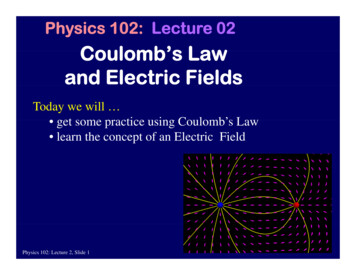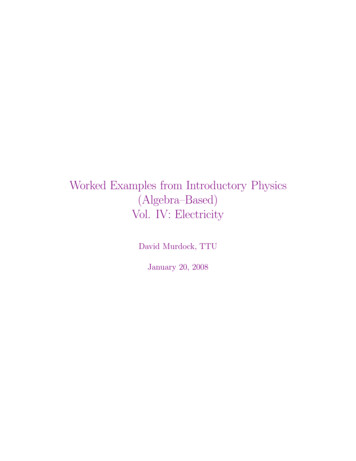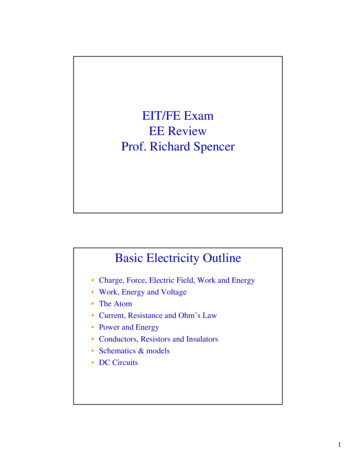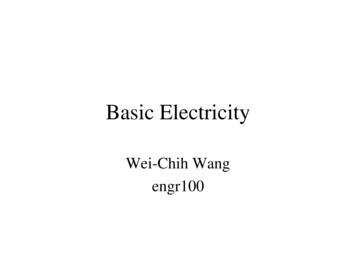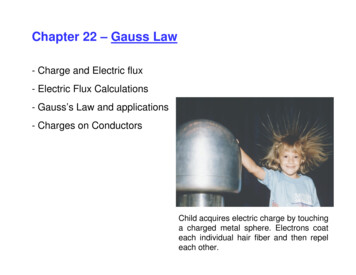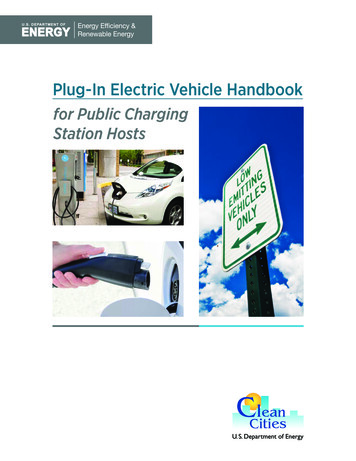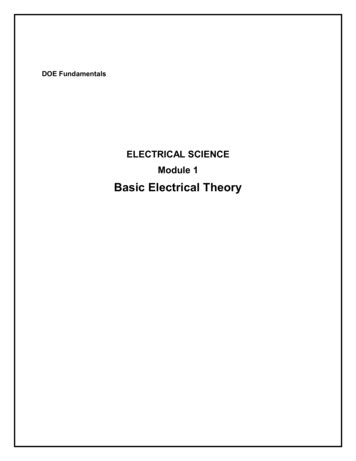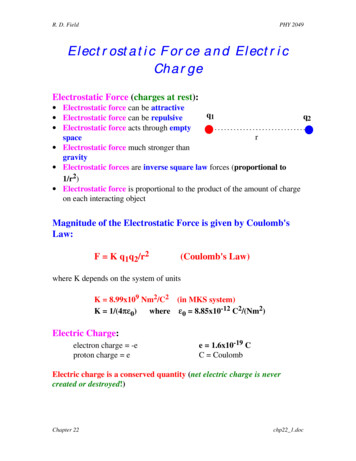
Transcription
R. D. FieldPHY 2049Electrostatic Force and ElectricChargeElectrostatic Force (charges at rest): Electrostatic force can be attractiveq1q2 Electrostatic force can be repulsive Electrostatic force acts through emptyrspace Electrostatic force much stronger thangravity Electrostatic forces are inverse square law forces (proportional to1/r2) Electrostatic force is proportional to the product of the amount of chargeon each interacting objectMagnitude of the Electrostatic Force is given by Coulomb'sLaw:F K q1q2/r2(Coulomb's Law)where K depends on the system of unitsK 8.99x109 Nm2/C2 (in MKS system)K 1/(4πεπε0)where ε0 8.85x10-12 C2/(Nm2)Electric Charge:electron charge -eproton charge ee 1.6x10-19 CC CoulombElectric charge is a conserved quantity (net electric charge is nevercreated or destroyed!)Chapter 22chp22 1.doc
R. D. FieldPHY 2049UnitsMKS System (meters-kilograms-seconds):also Amperes, Volts, Ohms, WattsForce:F maNewtons kg m / s2 1 NWork:W FdJoule Nm kg m2 / s2 1 JElectric Charge:QCoulomb 1 CF K q1q2/r2K 8.99x109 Nm2/C2 (in MKS system)CGS System (centimeter-grams-seconds):Force:Work:Electric Charge:F q1q2/r2F maW FdQK 11 dyne g cm / s21 erg dyne-cm g cm2 / s2esu (electrostatic unit)(in CGS system)Conversions (MKS - CGS):Force:Work:Electric Charge:1 N 105 dynes1 J 107 ergs1 C 2.99x109 esuFine Structure Constant (dimensionless):α K 2ππe2/hch Plank's ConstantChapter 22(same in all systems of units)c speed of light in vacuumchp22 2.doc
R. D. FieldPHY 2049Electrostatic Force versus GravityElectrostatic Force :Fe K q1q2/r2(Coulomb's Law)K 8.99x109 Nm2/C2(in MKS system)Gravitational Force :Fg G m1m2/r2(Newton's Law)G 6.67x10-11 Nm2/kg2(in MKS system)Ratio of forces for two electrons :e 1.6x10-19 Cm 9.11x10-31 kge, me, mrFe / Fg K e2 / G m2 4.16x1042Chapter 22(Huge number !!!)chp22 3.doc
R. D. FieldPHY 2049Vector Forces rqQThe Electrostatic Force is a vector:The force on q due to Q points along the direction r and is givenbyr KqQF r 2rq1F3F2Qq2F1q3Vector Superposition of Electric Forces:If several point charges q1, q2, q3, simultaneously exert electricforces on a charge Q thenF F1 F2 F3 Chapter 22chp22 4.doc
R. D. FieldPHY 2049Vectors & Vector AdditionThe Components of a vector:y-axisAy A sin θAθAx A cos θx-axisVector Addition:y-axisCBAx-axisTo add vectors you add the components of the vectors as follows:rA Ax x Ay y Az z rB Bx x By y Bz z r r rC A B ( Ax Bx ) x ( Ay By ) y ( Az Bz )z Chapter 22chp22 5.doc
R. D. FieldPHY 2049The Electric Dipole Q-QdAn electric "dipole" is two equal and opposite point chargesseparated by a distance d. It is an electrically neutral system.The "dipole moment" is defined to be the charge times theseparation (dipole moment Qd).Example Problem: Qdxq-QA dipole with charge Q and separation d is located on the y-axis with itsmidpoint at the origin. A charge q is on the x-axis a distance x from themidpoint of the dipole. What is the electric force on q due to the dipole andhow does this force behave in the limit x d (dipole approximation)?Example Problem:-Qd QxA dipole with charge Q and separation d is located on the x-axis with itsmidpoint at the origin. A charge q is on the x-axis a distance x from themidpoint of the dipole. What is the electric force on q due to the dipole andhow does this force behave in the limit x d (dipole approximation)?Chapter 22chp22 6.doc
R. D. FieldPHY 2049The Electric Field QqEThe charge Q produces an electric field which in turnproduces a force on the charge q. The force on q is expressedas two terms:F K qQ/r2 q (KQ/r2) q EThe electric field at the point q due to Q is simply the force perunit positive charge at the point q:E F/qE KQ/r2The units of E are Newtons per Coulomb (units N/C).The electric field is a physical object which can carry bothmomentum and energy. It is the mediator (or carrier) of theelectric force. The electric field is massless.The Electric Field is a Vector Field:r KQE 2 r rChapter 23chp23 1.doc
R. D. FieldPHY 2049Electric Field Lines Q-QElectric field line diverge from (i.e. start) on positive chargeand end on negative charge. The direction of the line is thedirection of the electric field.The number of lines penetrating a unit area that isperpendicular to the line represents the strength of the electricfield. QChapter 23 2Qchp23 2.doc
R. D. FieldPHY 2049Electric Field due to a Distributionof ChargedE K dQ/r2 rdQrThe electric field from a continuous distribution of charge isthe superposition (i.e. integral) of all the (infinite)contributions from each infinitesimal dQ as follows:rE K 2 rdQrandCharge Distributions: Linear charge density λ :lengthQ dQλ(x)λ( ) charge/unitLdQ λ dxFor a straight line dQ λ(x) dx andQ dQ λ( x)dxIf λ(x) λ is constant then dQ λ dx and Q λL,where L is the length.Chapter 23chp23 3.doc
R. D. FieldPHY 2049Charge DistributionsCharge Distributions: Linear charge density λ :lengthλ(θ) charge/unit arcdQ λ ds λ R dθRFor a circular arc dQ λ(θ) ds λ(θ) Rdθ andQ dQ λ (θ ) ds λ (θ ) RdθIf λ(θθ) λ is constant then dQ λ ds and Q λs, where s is thearc length. Surface charge density σ:σ(x,y)σ( ) charge/unit areadQ σ dAFor a surface dQ σ(x,y) dA andQ dQ σ( x, y)dAIf σ(x,y) σ is constant then dQ σ dA and Q σA,is the area.where A Volume charge density ρ: ρ(x,y,z)ρ() charge/unit volumedQ ρ dVFor a surface dQ ρ(x,y,z) dV andQ dQ ρ( x, y, z)dVIf ρ(x,y,z) ρ is constant then dQ ρ dV and Q ρV, where V isthe volume.Chapter 23chp23 4.doc
R. D. FieldPHY 2049Calculating the Electric FieldExample:PLxA total amount of charge Q is uniformily distributed along a thin straight rodof length L. What is the electric field a a point P on the x-axis a distance xfrom the end of the rod?rE Answer:KQx x ( x L)Example:PA total amount of charge Q is uniformilydistributed along a thin straight rod oflength L. What is the electric field a a pointP on the y-axis a distance y from themidpoint of the rod?Answer:yLrE KQy y 2 ( L / 2) 2y Example:A infinitely long straight rod has a uniformcharge density λ. What is the electric field apoint P a perpendicular distance r from therod?PrλAnswer:Chapter 23r 2 KλE r rchp23 5.doc
R. D. FieldPHY 2049Some Useful MathApproximations:(1 ε ) 1 pεpε 1(1 ε ) ε 1 pε1pεe 1 εε 1tan ε εε 1sin ε εε 1Indefinite Integrals:Chapter 23a2 (x2 (x2)dx )dx ax2 3/ 2 a2 3/ 2xx2 a2 1x2 a2chp23 6.doc
R. D. FieldPHY 2049Calculating the Electric FieldExample:A total amount of charge Q is uniformilydistributed along a thin semicircle ofradius R. What is the electric field a apoint P at the center of the circle?RPr 2 KQE x πR 2Answer:x-axisExample:A total amount of charge Q isuniformily distributed along athin ring of radius R. What isthe electric field a point P onthe z-axis a distance z from thecenter of the ring?RPz-axisPz-axiszrAnswer: E KQz( z 2 R 2 )3/2z Example:A total amount of charge Q isuniformily distributed on thesurface of a disk of radius R.What is the electric field apoint P on the z-axis a distancez from the center of the disk?RzAnswer:r 2 KQ z z E 2 1 2R z R2 Chapter 23chp23 7.doc
R. D. FieldPHY 2049Calculating the Electric FieldExample:What is the electric field generated by alarge (infinite) sheet carrying a uniformsurface charge density of σ coulombs permeter?Answer:Pzr σE z 2ε 0σExample:-σWhat is the electric field at a point Pbetween two large (infinite) sheetscarrying an equal but opposite uniformsurface charge density of σ?Answer:r σE z ε0PσChapter 23chp23 8.doc
R. D. FieldPHY 2049Flux of a Vector FieldFluid Flow: n n nθFlux vAFlux vA cosθFlux 0rConsider the fluid with a vector v which describes the velocity of the fluidat every point in space and a square with area A L2 and normal n . Theflux is the volume of fluid passing through the square area per unit time.Generalize to the Electric Field:Electric flux through the infinitesimal areadA is equal towherer rd Φ E dArdA An EdAθ ndΦ E dA cosθTotal Electric Flux through a Closed Surface:EnormalSurface SChapter 24r rΦ E E dASchp24 1.doc
R. D. FieldPHY 2049Electric Flux and Gauss' LawThe electric flux through any closed surface isproportional to the net charge enclosed.EnormalClosedSurface Sr r Qenclosed S E dA ε0For the discrete case the total charge enclosed is the sum over allthe enclosed charges:Q enclosed N qi 1iFor the continuous case the total charge enclosed is the integral ofthe charge density over the volume enclosed by the surface S:Qenclosed ρ dVSimple Case: If the electric field is constant over the surface andif it always points in the same direction as the normal to thesurface thenr rΦ E E dA EASThe units for the electric flux are Nm2/C.Chapter 24chp24 2.doc
R. D. FieldPHY 2049Conductors in Static EquilibriumConductor: In a conductor someConductorelectrons are free to move (withoutrestraint) within the volumn of thematerial (Examples: copper, silver, aluminum, gold)Conductor in Static Equilibrium:Conductor inWhen the charge distribution on astatic equilibriumconductor reaches static equilibriumE 0(i.e. nothing moving), the net electricV constantfield withing the conductingmaterial is exactly zero (and the electric potential is constant).Excess Charge: For a conductorin static equilibrium all the (extra)electric charge reside on thesurface. There is no net electriccharge within the volumn of theconductor (i.e. ρ 0).Electric Field at the Surface:Surface Charge DensityσConductor instatic equilibriumE 0V constantρ 0EThe electric field at the surface of aconductor in static equilibrium isnormal to the surface and has a magnitude, E σ/εε0, where σ isthe surface charge density (i.e. charge per unit area) and the netcharge on the conductor isQ σdA .SurfaceChapter 24chp24 3.doc
R. D. FieldPHY 2049Gauss' Law ExamplesProblem:A solid insulating sphere of radius Rhas charge distributed uniformly throughout itsvolume. The total charge of the sphere is Q. Whatis the magnitude of the electric field inside andoutside the sphere?Answer:rKQE out r r2rKQrE in r R3ConductingSphereRNet Charge QInsulating SphereRTotal Charge Qρ constantProblem:A solid conducting sphere of radius Rhas a net charge of Q. What is the magnitude of theelectric field inside and outside the sphere? Whereare the charges located?Answer: Charges are on the surface andrKQE out r 2rrE in 0Problem:A solid conducting sphere of radiusb has a spherical hole in it of radius a and has anet charge of Q. If there is a point charge -qlocated at the center of the hole, what is themagnitude of the electric field inside and outsidethe conductor? Where are the charges on theconductor located?Answer: Charges are on the inside and outsidesurface with Qin q and Qout Q-q andba-qNet Charge Qon conductorrK (Q q )E r b r 2rrE a r b 0 KqEr a r r2Chapter 24chp24 4.doc
R. D. FieldPHY 2049Gravitational Potential EnergyGravitational Force: F G m1m2/r2Gravitational Potential Energy GPE:U GPE mgh (near surface of the Earth)1Kinetic Energy: KE 2 m v2Total Mechanical Energy: E KE UWork Energy Theorem:W EB-EA (KEB-KEA) (UB-UA)(work done on the system)Energy Conservation: EA EB(if no external work done on system)Example:vi 0hvf ?A ball is dropped from a height h. What isthe speed of the ball when it hits theground?Solution: Ei KEi Ui mghEf KEf Uf mvf2/2Ei E f v f 2 ghChapter 25chp25 1.doc
R. D. FieldPHY 2049Electric Potential EnergyGravitational Force: F K q1q2/r2Electric Potential Energy: EPE U (Units Joules)12(Units Joules)Kinetic Energy: KE 2 m vTotal Energy: E KE U (Units Joules)Work Energy Theorem: (work done on the system)W EB - EA (KEB - KEA) (UB - UA)Energy Conservation: EA EB (if no external work done on system)Electric Potential Difference V U/q:BWork done (against the electric force)per unit charge in going from A to B(without changing the kinetic energy).A V WAB/q U/q UB/q - UA/qq(Units Volts1V 1 J / 1 C)Electric Potential V U/q: U qVUnits for the Electric Field (Volts/meter):N/C Nm/(Cm) J/(Cm) V/mEnergy Unit (electron-volt): One electron-volt is the amountof kinetic energy gained by an electron when it drops through oneVolt potential difference1 eV (1.6x10-19 C)(1 V) 1.6x10-19 Joules1 MeV 106 eVChapter 251 GeV 1,000 MeV1 TeV 1,000 GeVchp25 2.doc
R. D. FieldPHY 2049Accelerating Charged ParticlesExample Problem:A particle with mass Mand charge q starts from rest a the point A. What isits speed at the point B if VA 35V and VB 10VBAq(M 1.8x10-5kg, q 3x10-5C)?VA 35VSolution: EThe total energy of the particle at A and B isE A KE A U A 0 qV A1E B KE B U B Mv B2 qVB2VB 10V-.Setting EA EB (energy conservation) yields1Mv B2 q (V A V B )2(Note: the particle gains an amount of kineticenergy equal to its charge, q, time the change inthe electric potential.)Solving for the particle speed givesvB 2 q (V A V B )M(Note: positive particles fall from high potential tolow potential VA VB, while negative particlestravel from low potential to high potential,VB VA.)Plugging in the numbers givesvB Chapter 242 ( 3 10 5 C )( 25V ) 9 .1m / s .1.8 10 5 kgchp25 3.doc
R. D. FieldPHY 2049Potential Energy & ElectricPotentialMechanics (last semester!):Work done by force F in going from A to B:BWbyFA Br r F drAPotential Energy Difference U:BWagainstFA Br r U U B U A F drArr U U UF U x y z x y zElectrostatics (this semester):rrF qEElectrostatic Force:Electric Potential Energy Difference U:(work done against E in moving q from A to B)Br r U U B U A qE drAElectric Potential Difference V U/q:(work done against E per unit charge in going from A to B)Br r V V B V A E drArr V V VE V x y z x y zChapter 25chp25 4.doc
R. D. FieldPHY 2049The Electric Potential of a PointChargeV(r) QV(r) KQ/rErPotential from a point charge:V(r) V V(r) - V(infinity) KQ/rU qV work done against the electric force in bringing thecharge q from infinity to the point r. QqEPotential from a system of N point charges:V N i 1Chapter 25Kq irichp25 5.doc
R. D. FieldPHY 2049Electric Potential due to aDistribution of ChargedV K dQ/rdQrThe electric potential from a continuous distribution of chargeis the superposition (i.e. integral) of all the (infinite)contributions from each infinitesimal dQ as follows:V KdQrandQ dQExample:A total amount of charge Q is uniformilydistributed along a thin circle of radius R.What is the electric potential at a point P atthe center of the circle?RPKQV Answer:Rx-axisExample:A total amount of charge Q is uniformilydistributed along a thin semicircle ofradius R. What is the electric potential at apoint P at the center of the circle?KQAnswer: V RChapter 25RPx-axischp25 6.doc
R. D. FieldPHY 2049Calculating the Electric PotentialExample:A total amount of charge Q isuniformily distributed along athin ring of radius R. What isthe electric potential at a pointP on the z-axis a distance zfrom the center of the ring?RPz-axisPz-axiszAnswer: V ( z ) KQz2 R2Example:A total amount of charge Q isuniformily distributed on thesurface of a disk of radius R.What is the electric potential ata point P on the z-axis adistance z from the center ofthe disk?R2 KQV(z) Answer:R2Chapter 25z(z2 R2 z)chp25 7.doc
R. D. FieldPHY 2049Electric Potential EnergyFor a system of point charges:The potential energy U is the work required to assemble the final chargeconfiguration starting from an inital condition of infinite separation.q1Two Particles:q2rq1q2 1 Kq 2 1 Kq1 U K q1 q r2 r 2 2 r so we see that1U 22 qVi 1iiwhere Vi is the electric potential at i due to the other charges.Three Particles:qqqqqqU K 1 2 K 1 3 K 2 3r12r13r23q3r13q1which is equivalent toU 12r23q2r123 qViii 1where Vi is the electric potential at i due to the other charges.N Particles:1U 2Chapter 25N qViii 1chp25 8.doc
R. D. FieldPHY 2049Stored Electric Potential EnergyFor a conductor with charge Q:The potential energy U is the work required to assemble the final chargeconfiguration starting from an inital condition of infinite separation.For a conductor the total charge Q resideson the surfaceE 0 dqQ dQ σdA σdA Also, V is constant on and inside theconductor andV constantdU 11dQV V σ dA22and henceU 12Stored Energy: VdQ SurfaceU1V2conductor σdA Surface1VQ21 QV2where Q is the charge on the conductor and V is the electric potential ofthe conductor.For a System of N Conductors:1U 2N QViii 1where Qi is the charge on the i-th conductor and Vi is the electricpotential of the i-th conductor.Chapter 25chp25 9.doc
R. D. FieldPHY 2049Capacitors & CapacitanceCapacitor:Any arrangement of conductors that is used to store electric charge (will alsostore electric potential energy).Capacitance:C Q/VorUnits: 1 farad 1 F 1 C/1 VC Q/ V1 µF 10-6 F1 pF 10-9 FStored Energy:Uconductor1Q21 QV CV22C22where Q is the charge on the conductor and V is the electric potential of theconductor and C is the capacitance of the conductor.Example (Isolated Conducting Sphere):For an isolated conducting sphere with radius R, V KQ/R andhence C R/K and U KQ2/(2R).Example (Parallel Plate Capacitor):EQE Q/(Aε0)d-QChapter 26 σArea AArea AFor two parallel conductingplates of area A and separation dwe know that E σ/εε0 Q/(Aεε0)and V Ed Qd/(Aεε0) so thatC Aεε0/d. The stored energy isU Q2/(2C) Q2d/(2Aεε0). σchp26 1.doc
R. D. FieldPHY 2049Capacitors in Series & ParallelParallel:In this case V1 V2 V andQ Q1 Q2. Hence,Q Q1 Q2 C1 V1 C2 V2 (C1 C2) Vso C Q/ V C1 C2, where Iused Q1 C1 V1 andQ2 C2 V2.C1 VC2Capacitors in parallel add.Series:In this case V V1 V2 and Q Q1 Q2.Hence, V V1 V2 Q1/C1 Q2/C2 (1/C1 1/C2)Qso 1/C V/Q 1/C1 1/C2, where I usedQ1 C1 V1 and Q2 C2 V2.C1 VC2Capacitors in series add inverses.Chapter 26chp26 2.doc
R. D. FieldPHY 2049Energy Density of the ElectricFieldEnergy Density u:Electric field lines contain energy! The amount ofenergy per unit volume isEu e0E2/2,where E is the magnitude of the electric field. Theenergy density has units of Joules/m3.VolumeTotal Stored Energy U:The total energy strored in the electric field lines in an infinitessimal volumedV is dU u dV andU udVVolumeIf u is constant throughout the volume, V, then U u V.Example: Parallel Plate CapacitorThink of the work done in bringing in the chargesfrom infinity and placing them on the capacitor as thework necessary to produce the electric field lines andE-fielddthat the energy is strored in the electric field!From before we know that C Aεε0/d so that the-Qstored energy in the capacitor isU Q2/(2C) Q2d/(2Aεε0).The energy stored in the electric field is U uV e0E2V/2 withE σ/e0 Q/(e0A) and V Ad, thusU Q2d/(2Aεε0),which is the same as the energy stored in the capacitor!Area AChapter 26 Qchp26 3.doc
R. D. FieldPHY 2049Electric Energy ExamplesExample:How much electric energy is stored by asolid conducting sphere of radius R andtotal charge Q?Charge QEKQ 2Answer: U 2RRExample:-QQR1R2EHow much electric energy is stored by a two thinspherical conducting shells one of radius R1 andcharge Q and the other of radius R2 and charge -Q(spherical capacitor)?KQ 2 11 U Answer:2 R1 R2 Example:How much electric energy is stored by asolid insulating sphere of radius R andtotal charge Q uniformly distributedthroughout its volume?23 KQ 2 1 KQAnswer: U 1 5 2 R 5 RChapter 26Charge QEERchp26 4.doc
R. D. FieldPHY 2049Charge Transport and CurrentDensityqvConsider n particles per unit volumeall moving with velocity v and eachcarrying a charge q.AThe number of particles, N, passing through the (directed) area A in a timer r N nv A tand the amount of charge, Q, passing through t isthe (directed) area A in a time t isr r Q nqv A t .The current, I(A), is the amount of charge per unit time passing through the(directed) area A:rr r Qr rI ( A) nqv A J A , trrJ nqvwhere the "current density" is given bydrift .The current I is measured in Ampere's where 1 Amp is equal to oneCoulomb per second (1A 1C/s).For an infinitesimal area (directed) area dA:r rdI J dAandrdIJ n dA .The "current density" is the amount of current per unit area and has units ofA/m2. The current passing through the surface S is given byr vI J dAS.The current, I, is the "flux" associated with the vector J.Chapter 27chp27 1.doc
R. D. FieldPHY 2049Electrical Conductivity and OhmsLawFree Charged Particle:For a free charged particle in an electric field,rrr q rrF ma qEand thus a E .mThe acceleration is proportional to the electric field strength E and thevelocity of the particle increases with time!q mECharged Particle in a Conductor:However, for a charged particle in aconductor the average velocity isproportional to the electric fieldrrstrength E and since J nqvaveConductorqEwe haverrJ σE,where σ is the conductivity of the material and is a property of theconductor. The resistivity ρ 1/σσ.Length LOhm's Law:Conductor σElectric Field ECurrent Density JrrJ σEI JA σEAV1Potential Change VCurrent IAV2I L V EL L I RI σAσA V IR (Ohm's Law) R L/(σσA) ρL/A (Resistance)Units for R are Ohms 1ΩΩ 1V/1AChapter 27chp27 2.doc
R. D. FieldPHY 2049Resistors in Series & ParallelParallel:In this case V1 V2 Vand I I1 I2. Hence,I I1 I2 V1/R1 V2/R2 (1/R1 1/R2) V V1so 1/R I/ V 1/R1 1/R2,where I used I1 V1/R1 andI2 V2/R2. Also, V I1R1 I2R2 IR soI1 R2I/(R1 R2) and I2 R1I/(R1 R2).II2I1R1 V2R2 VResistors in parallel add inverses.Series:In this case V V1 V2 and I I1 I2.Hence, V V1 V2 I1R1 I2R2 (R1 R2)Iso R V/I R1 R2, where I used V1 I1R1 and V2 I2R2.I V1R1 V V2R2Resistors in series add.Chapter 27chp27 3.doc
R. D. FieldPHY 2049Direct Current (DC) CircuitsII VEMFVEMF V 0Electromotive Force:The electromotive force EMF of a source of electric potential energy isdefined as the amount of electric energy per Coulomb of positive charge asthe charge passes through the source from low potential to high potental.EMF ε U/q(The units for EMF is Volts)Single Loop Circuits:ε - IR 0and I ε /R(Kirchhoff's Rule)Iε R-Power Delivered by EMF (P εI):dWdqd W ε dq P ε εIdtdtPower Dissipated in Resistor (P I2R):dUdqdU V R dq P VR VR IdtdtChapter 28chp28 1.doc
R. D. FieldPHY 2049DC Circuit RulesLoop Rule:IThe algebraic sum of the changes inpotential encountered in a completetraversal of any loop of a circuit must bezero. VEMF- VEMF V 0iloop 0 .Junction Rule:The sum of the currents entering any junctionmust be equal the sum of the currents leavingthat junction. I IiinioutIResistor: V -IRIf you move across a resistor in the directionof the current flow then the potential change is VR - IR.Capacitor:IQ - V Q/CIf you move across a capacitor from minus to plus thenthe potential change is VC Q/C,and the current leaving the capacitor is I -dQ/dt.Inductor (Chapter 31):If you move across an inductor in the direction ofthe current flow then the potential change is VL - L dI/dt.Chapter 28IL VL -LdI/dtchp28 2.doc
R. D. FieldPHY 2049Charging a CapacitorSwitchAfter the switch is closed the current isentering the capacitor so that I dQ/dt,where Q is the charge on the capacitorand summing all the potential changes ingoing around the loop givesR εC-ε IR Q 0 ,Cwhere I(t) and Q(t) are a function of time. If the switch is closed at t 0 thenQ(0) 0 andε RdQ Q 0 ,dtCwhich can be written in the formdQ1 (Q ε C ) , where I have define τ RC.dtτDividing by (Q-εC) and multipling by dt and integrating gives Q0dQ1t Q εC dt , which implies ln . εC τ(Q ε C ) 0 τtSolving for Q(t) givesCharging a Capacitor1.50Q ( t ) ε C (1 e t / τ ).1.251.00Q(t) 0.750.500.250.000The curent is given byI(t) dQ/dt which yieldsI (t ) 123TimeεC t /τεe e t / τ . The quantity τ RC is call the timeτRconstant and has dimensions of time.Chapter 28chp28 3.doc4
R. D. FieldPHY 2049Discharging a CapacitorAfter the switch is closed the current isleaving the capacitor so that I -dQ/dt,where Q is the charge on the capacitor andsumming all the potential changes in goingaround the loop givesSwitch CR-Q IR 0 ,Cwhere I(t) and Q(t) are a function of time. If the switch is closed at t 0 thenQ(0) Q0 andQdQ R 0 ,Cdtwhich can be written in the formdQ1 Q , where I have defined τ RC.dtτDividing by Q and multiplying by dt and integrating gives QQ0t Q tdQ1 dt , which implies ln .τQτ Q0 0Solving for Q(t) givesDischarging a Capacitor1.00Q (t ) Q0e t /τ .0.75Q(t)0.500.25The current is given byI(t) -dQ/dt which yieldsI (t ) 0.0001234TimeQ0 t / τe.RCThe quantity τ RC is call the "time constant" and has dimensions of time.Chapter 28chp28 4.doc
R. D. FieldPHY 2049The Electromagnetic ForceThe Force Between Two-Charged Particles (at rest):The force between two charged particles at rest isthe electrostatic force and is given byv 0qrKQqFE r (electrostatic force) ,r2rrwhere K 8.99x109 Nm2/C2.QV 0The Force Between Two Moving Charged Particles:The force between two moving charged particles isthe electromagnetic force and is given byvqrKQqKQq r r FE M r 2 2 v V r r2c rr(electromagnetic force)where K 8.99x109 Nm2/C2 and c 3x108 m/sQ(speed of light in a vacuum). The first term is theelectric force and the second (new) term is the called the magnetic force sorVrrrthat FE M FE FB , withrrKQq KQ FE 2 r q 2 r qE r rrKQq r rr KQ r r rFB 2 2 v V r qv 2 2 V r qv B c r c rElectric and Magnetic Fields of aCharged Particle Q moving withSpeed V (out of the paper)QEBChapter 29The electric and magnetic fields due to theparticle Q arer KQE 2 r rr KQ rB 2 2 V r crThe electromagnetic force on q is given byrrrrFE M qE qv B (Lorenz Force).chp29 1.doc
R. D. FieldPHY 2049The Magnetic ForceThe Force on Charged Particle in a Magnetic Field:BθqvThe magnetic force an a charged particle q in a magnetic fieldB is given byrr rFB qv B .The magnitude of the magnetic force is FB qvB sinθθ andB FB/(qv sinθθ) is the definition of the magnetic field. (Theunits for B are Tesla, T, where 1 T 1 N/(C m/s)). The magnetic forcean infinitesimal charged particler dq in a magneticr field B is given byrdF B dqv B .The Force on Wire Carrying a Current in a Magnetic Field:A current in a wire corresponds tomoving charged particles withI dq/dt. The magnetic force onthe charge dq isB-outrrrdF B dqv B ,dqIdldFand the speed v dl/dt. Hence,rrdlrdqv dq Idl ,dtand rthe magnetic forcer on avdF Idl B . The totalinfinitesimal length dl of the wire becomesBmagnetic force on the wire isrrFB dFB v r Idl B ,which for a straight wire of length L in a uniform magnetic field becomesrr rFB IL B .Chapter 29chp29 2.doc
R. D. FieldPHY 2049Vector Multiplication: Dot & CrossTwo Vectors:Define two vectors according toBrA A x x A y y A z z rB B x x B y y B z z .θAThe magnitudes of the vectors is given byrA A rB B A x2 A y2 A z2B x2 B y2 B z2Dot Product (Scalar Product):The dot product, S, is a scalar and is given byr rr rS A B A B cosθ Ax B x Ay B y Az BzCross Product r(Vector Product):The cross product, C , is a vector and is given byr r rC A B ( Ay Bz Az By ) x ( Ax Bz Az Bx ) y ( Ax By Ay Bx )z The magnitude of the cross product is given byr r r r rC A B A B sinθThe direction of the cross product can be determined from the "right handrule".Determinant Method:The cross product can be constructed by evaluating the followingdeterminant:x r r rC A B AxBxChapter 29y z AyByAzBzchp29 3.doc
R. D. FieldPHY 2049Motion of a Charged Particle in aMagnetic Fieldy-axisConsider a charged particle qwith velocityrv v x x v y y ,and kinetic energyvq x-axisRE kin 11 r rmv 2 mv v ,22in a uniform magnetic fieldrB Bz .The magnetic force on theparticle is rgiven by rB-inrFB qv B .The magnetic force does not change the speed (kinetic energy)of the charged particle. The magnetic force does no work on thecharged particle since the force is always perpendicular to the path of theparticle. There is no change in the particle's kinetic energy and no change inits speed.rrrdvdvr rr rF qv B mm qv B . HenceProof: We know thatBdtdtr rrdE kin 1 dv 2 1 d ( v v )r dvr r r m m mv qv v B 0 ,22dtdtdtdtand thus Ekin (and v) are constant in time.The magnetic force can change the direction a charged particle but not itsspeed. The particle undergoes circular motionv(t dt)with angular velocity ω qB/m.Fdt/mdθv(t)Chapter 29FqvBdt dtmmdθqBω dtmvd θ chp29 4.doc
R. D. FieldPHY 2049Circular Motion: Magnetic vsGravitationalPlanetary Motion:For circular planetary motion the force onthe orbiting planet is equal the mass timesthe centripetal acceleration, a v2/r, asfollows:FG GmM/r2 mv2/rSolving for the radius and speed gives,r GM/v2 and v (GM/r)1/2. ThevMrmperiod of the rotation (time it takes to go around once) is given by2πT 2ππr/v 2ππGM/v3 or T θ /dt,r 3 / 2 . The angular velocity, ω dθGMand linear velocity v ds/dt are related by v rωω, since s rθθ . Thus,3/2ω GM / r . The angular velocity an period are related by T 2ππ/ωωand the linear frequency f and ω are related by ω 2ππf with T 1/f. Planetsfurther from the sum travel slower and thus have a longer period T.Magnetism:vqrB-inFor magnetic circular motion the force onthe charged particle is equal its masstimes the centripetal acceleration,a
R. D. Field PHY 2049 Chapter 22 chp22_3.doc Electrostatic Force versus Gravity Electrostatic Force : F e K q 1q 2/r2 (Coulomb's Law) K 8.99x10 9 Nm 2/C 2 (in MKS system) Gravitational Force : F g G m 1m 2/r2 (Newton's Law) G 6.67x10-11 Nm 2
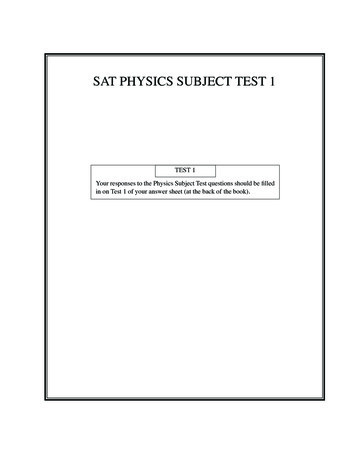
![2 CHAPTER 1 [Topic 1] Coulomb's law, electrostatic field and electric .](/img/52/physics.jpg)
